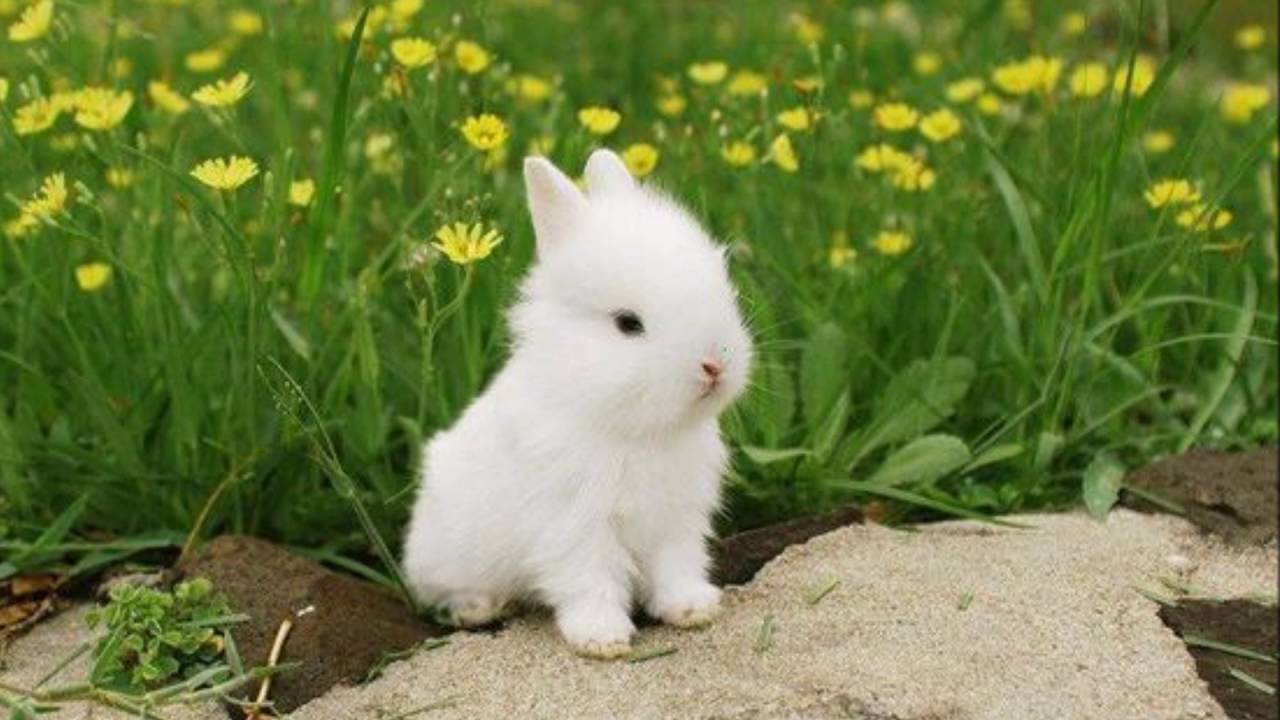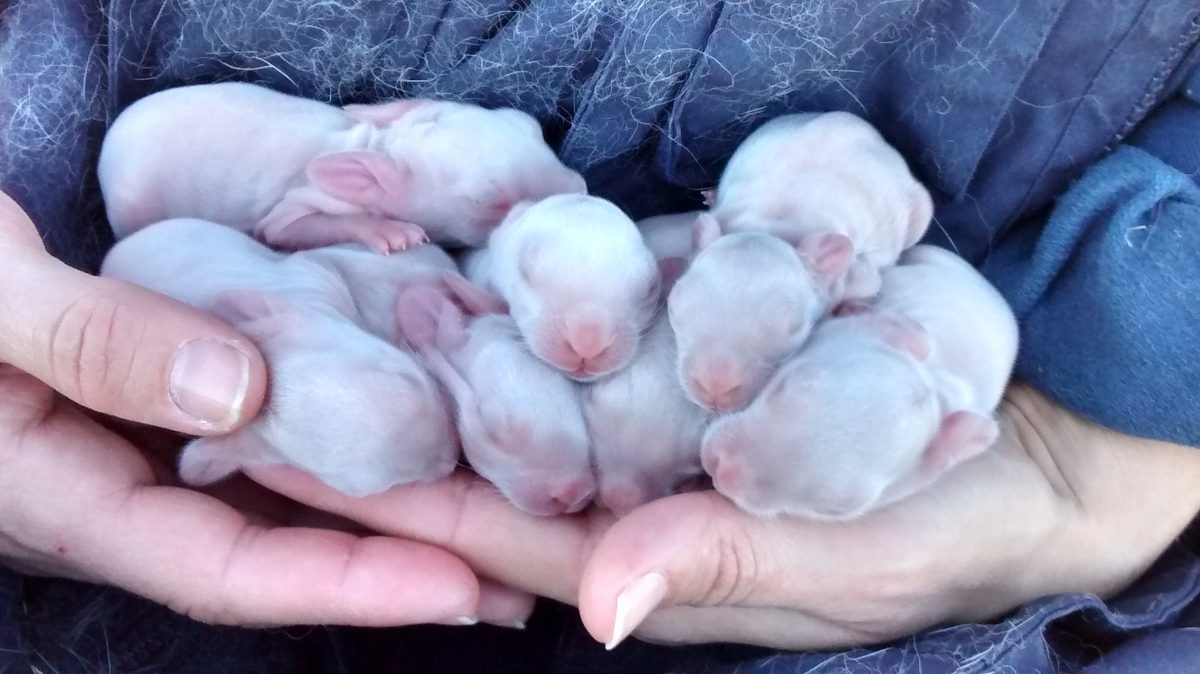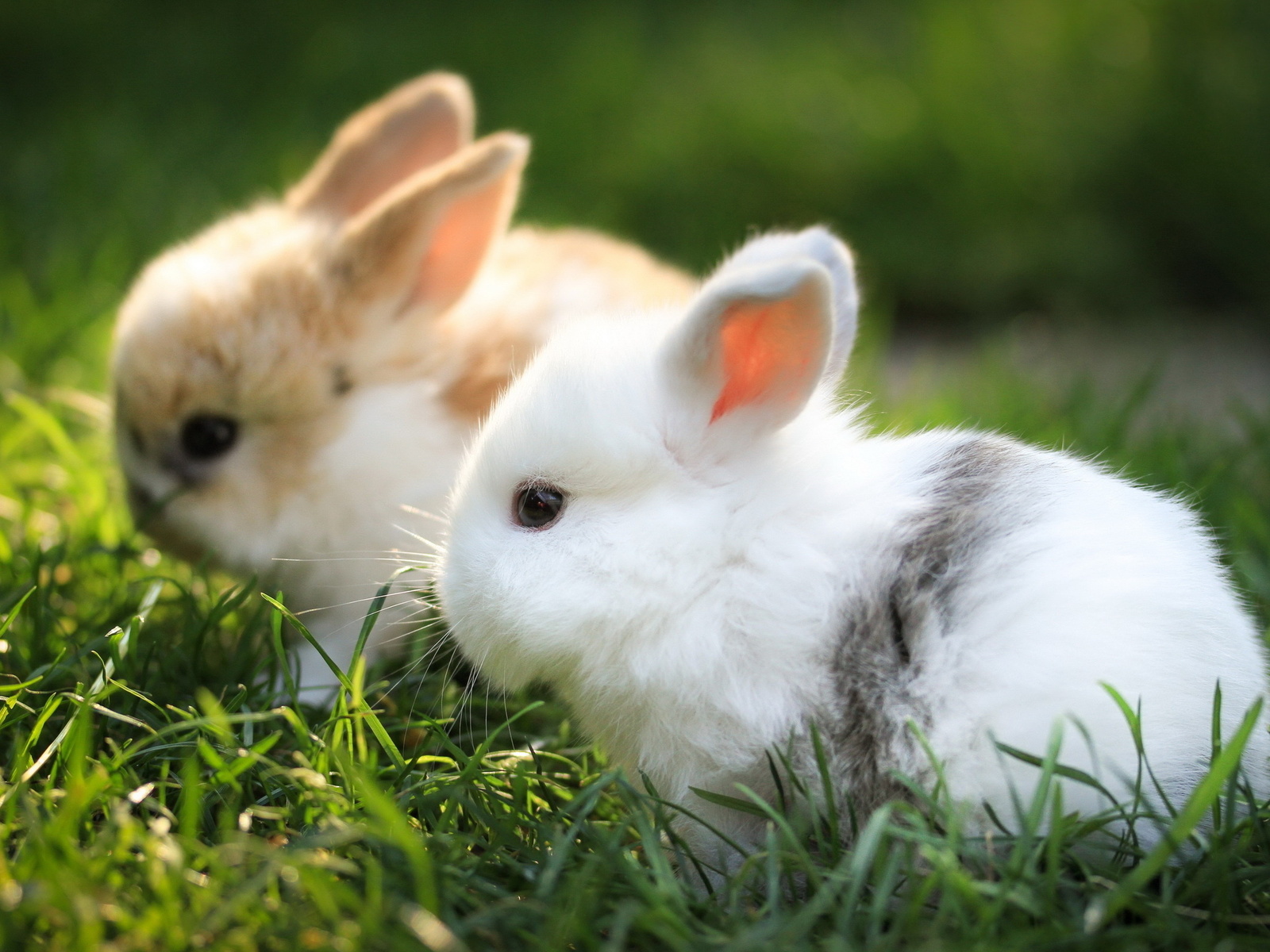Over time, and especially in recent years, rabbits have become quite popular as pets due to their adorable and affectionate appearance. For this reason, if you decided to adopt a small newborn rabbit, you will wonder what care it requires and what it eats. If you want to learn much more and know what baby rabbits eat, do not hesitate for a moment to continue reading this great article.

What do baby rabbits eat?
We emphasize that it is quite important before adopting a rabbit, especially a baby rabbit, that you inform yourself and investigate enough about the special care and feeding that it should take, because you should know that in each phase of the growth of a rabbit, they require different specific care and also special and balanced diets. The correct feeding of a baby rabbit does not only depend on choosing a couple of green foods or some feed that you can find in pet stores, remember that at this early stage of its life, its overall health depends entirely on how it is fed.
The rabbit's first food
During the first days of a baby rabbit's life, it will only feed on its own mother's milk. The most advisable thing is that the rabbit begins to consume it from the moment of its birth, up to seven weeks later, however, it is well known that not all rabbits have the same fate. In this way, if you adopt a small rabbit that is not yet seven weeks old, you must supply it with a prepared formula of goat's milk, which you will then supply with the help of a bottle, specifically in the afternoon, from the same way his own mother would.
Under no circumstances try to give your little rabbit any food that is not according to its growth stage, they can be intolerant to a large amount of food and give them diarrhea, unfortunately, if a rabbit suffers from diarrhea in its first days of life, it will die of dehydration within a few days.
How to give milk to Baby Rabbits?
If the baby rabbit is away from its mother, you must make sure that the homemade milk you prepare for it contains exactly the same nutrients that can be found in the original mother's milk, at the same time that it does not generate gas or diarrhea. For this reason, it is best to prepare a special milk formula for these little baby rabbits, which is based on goat's milk, a small spoonful of corn syrup and the yolk of an egg. In case you cannot find this formula, you can perfectly use the formula that is prescribed for newborn cats; What you should avoid at all costs is cow's milk, as it will cause diarrhea in your pet.
Now, before you start giving your little rabbit the formula, the first thing you should do is slightly warm the milk and put it in a dropper, or a bottle with a very small nozzle, make sure that the temperature is right and don't burn him Below, you can see a detailed list about the correct way to provide milk to your rabbit:
- First of all, hold your rabbit in your arms with its little legs down, avoid at all costs feeding it with its belly up; after this, try to raise your head, whenever you handle or hold it in any way, do it in a way that feels completely calm and comfortable. The intention of this act is to simulate as much as possible the posture that the little bunny would adopt to consume its mother's milk.
- Once you have your rabbit in this position, introduce the tip of the bottle with a small nozzle to the side of its mouth, never do it from the front. However, after you've inserted it into its mouth, you can move it slightly forward.
- Once this point is reached, squeeze the bottle very gently so that the milk begins to come out, once your rabbit feels the taste, it will begin to suck it on its own.
- Once you can see how your rabbit's belly looks round, you will know that it has been completely filled.
As you can see, it really is quite simple to feed one of these little animals. Despite the fact that their own mothers usually feed them approximately once or twice a day, since you do not have original breast milk, you will have to feed it a few more times to ensure that your rabbit is receiving all the necessary nutrients for its correct development; You must be quite attentive to his behavior, and thus notice exactly how many times he is hungry.
You must consider very well that the amount supplied must increase as time goes by and your rabbit begins to grow much more. First, you'll start with a very small dose of just three milliliters at each of his meals during his first week of life, twice each day, until you finally get to fifteen milliliters at each meal by about week six or seven.
Obviously, all these amounts are completely indicative, since each baby rabbit requires a different amount of nutrients depending on its size. Taking this into account, as we mentioned before, it is of the utmost importance that you research very well the type of rabbit you want to adopt, and once you have adopted it, you must immediately take it to a veterinarian so that they can examine it correctly and determine what the quantity is. exact amount of milk to drink each day and how long to drink it for until your body is sufficiently developed.
Hay in the Rabbit's diet
A very recurrent food in the diet of young rabbits is hay. This food can bring enormous benefits for the teeth of these kits, as well as for their digestive system, not to mention that the hay helps them in a great way in completely eliminating the hairballs. In the wild, rabbits tend to nibble a bit on the grass or grass that is in their entire environment, however, at home the best option you have is to use hay.
The most advisable thing is that you supply hay, either grass or alfalfa, although during the first stages of its life it will always be much better to opt for alfalfa hay, because it contains many more nutrients and more calcium. Despite this, it is a food that is contraindicated in all those rabbits that are more than six months old.
Now, the main topic is when to start giving a baby rabbit hay? Well, the most recommended thing is that when your rabbit reaches the third week of life, you start to introduce it in extremely small portions, without abandoning the mother's milk. Just as it happens with almost all the puppies in the animal kingdom, when making any type of change in their routine or in their diet, it is best to do it progressively to avoid any type of unwanted repercussion, in this way, as Before your rabbit begins to grow, you must gradually remove milk from its diet, and increasingly increase the amount of hay that you give it daily.
I think or pellets for Rabbits?
Once you start giving your rabbit its feed, you should know that you have to do it in a moderate way according to its size, and also make sure that it is of optimal quality. Do not fall for the false advertising of any product, when you are buying the feed or pellet for your little rabbit, take your time to thoroughly review all the ingredients.
Many of these products claim in their advertisements to be the ones indicated for your rabbit, however, when you check their label carefully, you will easily notice the high amounts of fat, protein and also sugar. You must discard any feed that contains any seed, nut, or any such food.

Good quality feed and pellets are made up entirely of different pure fiber ingredients, which will be much better suited to the body and digestive system, providing all the required nutrients and avoiding any problems you may have with your diet. obesity, fatty liver, constipation and even sugar addiction. In this way, approximately when your rabbit reaches the first five weeks of life, you can begin to introduce this food little by little.
Introduction to solid foods
First of all, remember that the stomach of these small animals is quite sensitive, for this reason, the vast majority of veterinarians advise trying different vegetables little by little, with fairly small portions, but also not without suddenly offering a wide variety of foods. . Otherwise, you could give your rabbit diarrhea or endless stomach problems, which, at a young age, could even lead to a painful death. The best vegetables to feed your rabbit at a young age are the following:
- Chard
- Celery
- Cilantro
- Lettuce
- Cauliflower
- Tomato
- Cucumber
- Radish
- Spinach
- Kale
- Oats flakes
- Artichoke
- Mustard leaves
Remember that all the foods mentioned must be given in fairly small amounts, and then increase over time, so that your rabbit can get used to eating this way, and above all, not suffer any type of condition. Remember that you can also feed some fruits in small portions, among this variety of fruits suitable for rabbits, we find the following:
- Strawberry
- Papaya
- Apple
- Pear
- Pineapple
- Apricot
- Peach
- Mango
Very well, now that you have known very well each and every one of the foods that you can supply to your little rabbit, below you will be able to see in detail the form and the correct amounts that you should give according to its size or the situation in which be found.
How to feed a Wild Baby Rabbit?
In the event that you have rescued a small baby rabbit or a litter of rabbits from the street, and you do not really know how to feed them correctly, then you will see in detail how to do it. It is not at all the same, adopting a small rabbit to have it as a pet, than rescuing it and helping it and then returning it to its natural habitat. For this reason, if all you want is to temporarily help a baby rabbit and then return it to nature, you just have to follow all these recommendations:
- Effectively manages formula milk throughout the first week of life; remember that it is very important to follow the steps that we mentioned before to feed him with this formula milk.
- Try as much as possible to manipulate the rabbit as little as possible, otherwise it could get used to you and create an emotional bond with you and start depending on you to perform some care.
- Once he completes the second week with you, start offering him small portions of very fresh grass and then let the same rabbit eat it on his own, alternating of course with the formula milk. Never forget to color a small container with water very low to avoid drowning with it.
- Once it has reached the third week, start adding very small pieces of vegetables to its diet and pay close attention that it does not harm the rabbit. See that he always has water to digest food and stay hydrated.
- Once you begin to notice that the rabbit can feed itself, drink water on its own and walk without any difficulty, put the cage you were using in your garden or some open space, in this way the rabbit can gradually get used to live outdoors.
- As long as it is under your supervision, you should release it and let it run around the garden on its own. Once this little guy is able to fend for himself, he tries to find a good area to set him free. Make sure there are other rabbits in the same area.
How to feed an orphaned Baby Rabbit?
There are endless reasons why any rabbit could end up without a mother, among these may be that its mother has died or even that its mother completely rejects it and has to find a life alone. In the event that you have adopted a small rabbit without a mother, you must follow this schedule to the letter to feed it, however, remember that the most important thing is to take it to a veterinarian as quickly as possible.
Week 1 and 2: You will only give him the formula mentioned above at noon, and then another dose in the late afternoon.
Week 3 and 4: You will continue to supply formula milk on the same schedule. Then put a very large amount of alfalfa hay in his cage, so the little rabbit can eat whenever he's hungry.
Week 5, 6 and 7: As in the previous weeks, you will continue to supply the milk at the same times, however, you should slightly reduce the milliliters that you give for each feeding. Feed it with alfalfa hay and with a feed that is a very good quality.
8 Week: This is the week of weaning, once the eighth week is over, you should not give formula milk anymore. At this stage, your rabbit will only feed on alfalfa hay, an optimal quality feed, and you will begin to introduce different raw solid foods into its diet, these will be in the form of fruits or vegetables.
Do not forget that as your rabbit grows in the first weeks, you should slightly increase the amount of milliliters of formula milk that you give him for each feeding, as we indicated earlier in this article. Then, you should reduce it slightly until finally your rabbit reaches the weaning phase.
How to feed a Domestic Baby Rabbit?
Once your rabbit reaches the eighth week, up to the first seven months of life all the final growth of the rabbit takes place, a growth that begins as a baby rabbit until it becomes an adolescent rabbit or a young rabbit. Until he is three months old, the majority of his diet will consist of alfalfa hay, kibble, and also some occasional pellets and very small portions of fruits and vegetables.
Then, from the fourth month onwards, all the raw food portions will start to increase much more, and then over time they will gradually replace the dry food. After your rabbit reaches seven months of age, you can start fully feeding it like an adult. If you offer him a slightly varied diet in fruits and also vegetables, or you will have the need to use processed feed or some type of vitamin supplement.
However, if you really consider it important that your rabbit has this food in its diet, or your trusted veterinarian has indicated it to you, make sure you investigate very well the adequate amounts for each rabbit. In addition to this, that same month you should start introducing grass hay into your diet, and gradually leave the alfalfa hay. It is important to remember again, that you should always offer an endless supply of fresh water regardless of the age or size of the rabbit, in turn, pay close attention to all the reactions it has to different foods.
If you want to learn much more about all the animals throughout the entire planet, do not hesitate for a moment to leave this page, without first having read any of these three wonderful articles:



